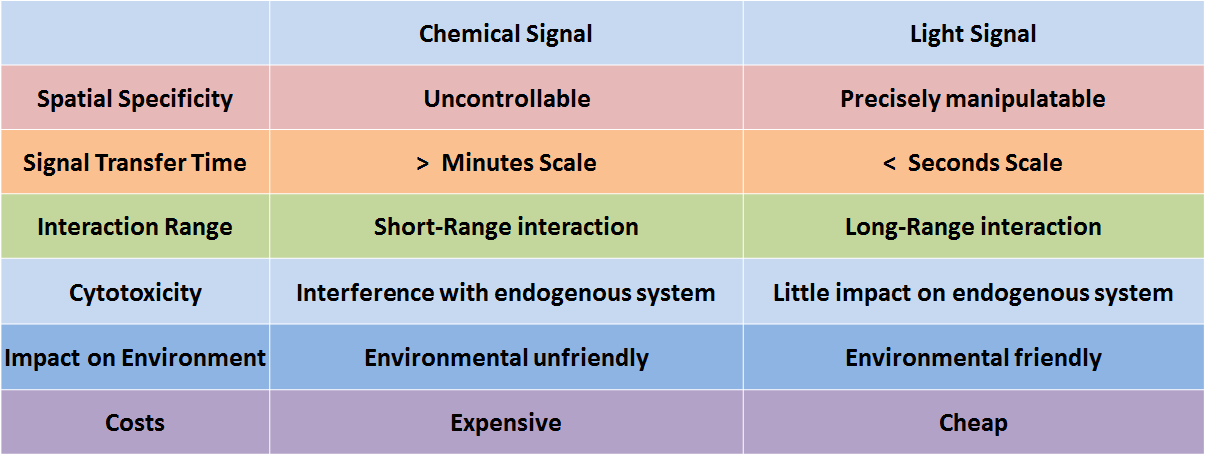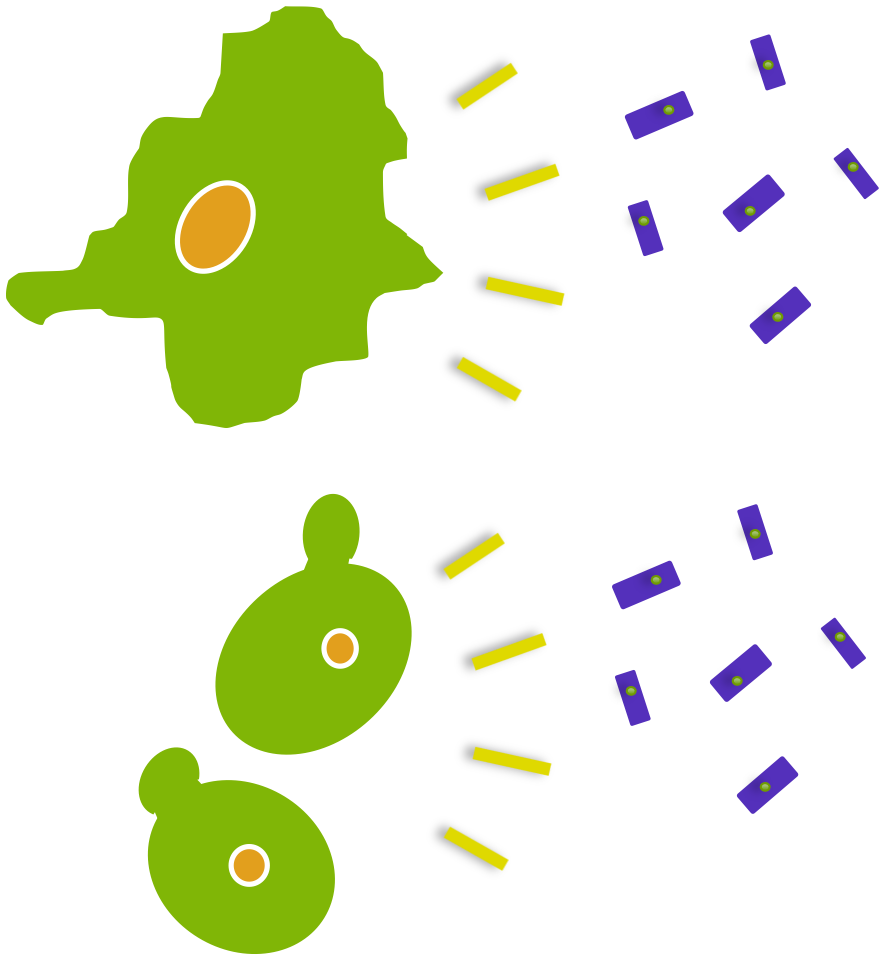Team:Peking/Project/Communication/Future
From 2012.igem.org
| (2 intermediate revisions not shown) | |||
| Line 10: | Line 10: | ||
<div class="PKU_context floatR first"> | <div class="PKU_context floatR first"> | ||
| - | <h3 class="title1"> | + | <h3 class="title1">Prospective</h3> |
<p> | <p> | ||
| + | |||
| + | |||
| + | |||
The communication between cells is an indispensable element to program cell population behavior, such as synchronization, fate differentiation, and even pattern formation. In our project, we proved the feasibility of cell-cell communication through light, a physical mode, for the very first time in synthetic biology. Despite the fact that more efforts are necessary to elucidate the reliability of inter-cellular communication via light, its significance can be best understood when compared with chemical communication.<br /><br /> | The communication between cells is an indispensable element to program cell population behavior, such as synchronization, fate differentiation, and even pattern formation. In our project, we proved the feasibility of cell-cell communication through light, a physical mode, for the very first time in synthetic biology. Despite the fact that more efforts are necessary to elucidate the reliability of inter-cellular communication via light, its significance can be best understood when compared with chemical communication.<br /><br /> | ||
| + | |||
| + | |||
| + | |||
</p> | </p> | ||
<div class="floatC"> | <div class="floatC"> | ||
| Line 19: | Line 25: | ||
</div> | </div> | ||
<p> | <p> | ||
| - | Intuitively, light signal propagates much faster than chemical signals because it bypasses chemical diffusion. This provides a superior mechanism for cell signaling and thus a rapid response is guaranteed. <br /><br />Additionally, the most frequent ‘calling distance’ reported for quorum sensing is in the micrometer ranges, and very rarely in millimeter ranges in synthetic biology cases. However, we demonstrated that light communication can operate over millimeter to centimeter ranges since light can easily propagate across transparent media, thus able to directly affect enzyme activity or gene expression. Not surprisingly, light signals can be expected to couple biochemical reactions and cellular behaviors that are spatially separated by millimeter to centimeter distances. <br /><br />Besides, it is notable that the bacterial cell size (approximately 1.0 μm) is comparable to the wavelength of blue light (in our case, 0.46μm). Therefore, it will be interesting to see how optical phenomena such as scattering and diffraction affect, or even guide, the formation of microstructures such as colonies or biofilms, when cell-cell communication through light is brought in. <br /><br />What’s more, the most fascinating feature of light signaling among cells is far beyond that of its intra-species capabilities. Inter-species and even inter-kingdom communication, such as that between bacteria and yeast or between bacteria and mammalian cells, will not merely exist as an idea due to the ability of our cells to be easily engineered to emit luminescence. Last but not least, our <i>Luminesensor</i> can also be easily adjusted to work in different cell types due to its modularity. | + | |
| + | |||
| + | |||
| + | Intuitively, light signal propagates much faster than chemical signals because it bypasses the need for chemical diffusion. This provides a superior mechanism for cell signaling and thus a rapid response is guaranteed. <br /><br /> | ||
| + | |||
| + | |||
| + | |||
| + | |||
| + | Additionally, the most frequent ‘calling distance’ reported for quorum sensing is in the micrometer ranges, and very rarely in millimeter ranges in synthetic biology cases. However, we demonstrated that light communication can operate over millimeter to centimeter ranges since light can easily propagate across transparent media, thus able to directly affect enzyme activity or gene expression. Not surprisingly, light signals can be expected to couple biochemical reactions and cellular behaviors that are spatially separated by millimeter to centimeter distances. <br /><br /> | ||
| + | |||
| + | |||
| + | |||
| + | |||
| + | As a hallmark of coordinated cellular behavior, pattern formation typically required cell-cell communication and intracellular signal processing. For more site-specific signaling and pattern formation, light may be more appropriate alternative. Due to the high sensitivity of our <i>Luminesensor</i>, it is possible to construct a ring-like pattern based on light-communication, previously done by AHL. This kind of flexibility enables its application in tissue-engineering, bio-sensing and bio-manufacturing. (See <a href="/Team:Peking/Modeling/Ring">Modeling Ring Pattern</a>)<br /><br /> | ||
| + | |||
| + | |||
| + | |||
| + | |||
| + | Besides, it is notable that the bacterial cell size (approximately 1.0 μm) is comparable to the wavelength of blue light (in our case, 0.46μm). Therefore, it will be interesting to see how optical phenomena such as scattering and diffraction affect, or even guide, the formation of microstructures such as colonies or biofilms, when cell-cell communication through light is brought in. <br /><br /> | ||
| + | |||
| + | |||
| + | |||
| + | What’s more, the most fascinating feature of light signaling among cells is far beyond that of its intra-species capabilities. Inter-species and even inter-kingdom communication, such as that between bacteria and yeast or between bacteria and mammalian cells, will not merely exist as an idea due to the ability of our cells to be easily engineered to emit luminescence. Last but not least, our <i>Luminesensor</i> can also be easily adjusted to work in different cell types due to its modularity. | ||
</p> | </p> | ||
<div class="floatC"> | <div class="floatC"> | ||
Latest revision as of 17:14, 21 October 2012
Prospective
The communication between cells is an indispensable element to program cell population behavior, such as synchronization, fate differentiation, and even pattern formation. In our project, we proved the feasibility of cell-cell communication through light, a physical mode, for the very first time in synthetic biology. Despite the fact that more efforts are necessary to elucidate the reliability of inter-cellular communication via light, its significance can be best understood when compared with chemical communication.

Figure 1. Comparison of chemical signal and light signal
Intuitively, light signal propagates much faster than chemical signals because it bypasses the need for chemical diffusion. This provides a superior mechanism for cell signaling and thus a rapid response is guaranteed.
Additionally, the most frequent ‘calling distance’ reported for quorum sensing is in the micrometer ranges, and very rarely in millimeter ranges in synthetic biology cases. However, we demonstrated that light communication can operate over millimeter to centimeter ranges since light can easily propagate across transparent media, thus able to directly affect enzyme activity or gene expression. Not surprisingly, light signals can be expected to couple biochemical reactions and cellular behaviors that are spatially separated by millimeter to centimeter distances.
As a hallmark of coordinated cellular behavior, pattern formation typically required cell-cell communication and intracellular signal processing. For more site-specific signaling and pattern formation, light may be more appropriate alternative. Due to the high sensitivity of our Luminesensor, it is possible to construct a ring-like pattern based on light-communication, previously done by AHL. This kind of flexibility enables its application in tissue-engineering, bio-sensing and bio-manufacturing. (See Modeling Ring Pattern)
Besides, it is notable that the bacterial cell size (approximately 1.0 μm) is comparable to the wavelength of blue light (in our case, 0.46μm). Therefore, it will be interesting to see how optical phenomena such as scattering and diffraction affect, or even guide, the formation of microstructures such as colonies or biofilms, when cell-cell communication through light is brought in.
What’s more, the most fascinating feature of light signaling among cells is far beyond that of its intra-species capabilities. Inter-species and even inter-kingdom communication, such as that between bacteria and yeast or between bacteria and mammalian cells, will not merely exist as an idea due to the ability of our cells to be easily engineered to emit luminescence. Last but not least, our Luminesensor can also be easily adjusted to work in different cell types due to its modularity.

Figure 2. Inter-Kingdom signaling between mammalian/yeast cells and bacteria using Luminesensor
 "
"










